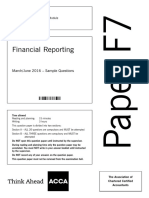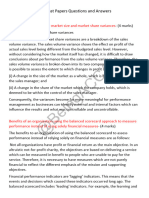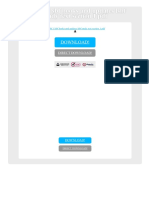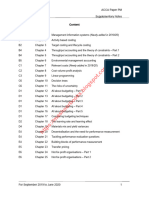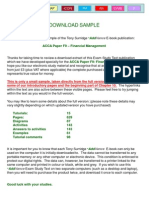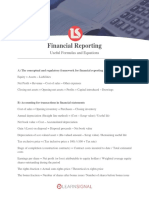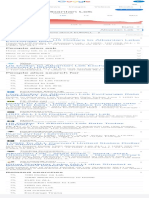F2 Management In Accounting Sir Ahmed Shafi
VARIANCES
1) MPV= Actual qty consumed/actual qty purchased x ( Actual price perkg-std price per kg)
2) MUV=Standard price per kg x( Actual Qty consumed-std Qty allowed)
Where:
Std Qty allowed=(Actual units produced x std qty Per unit)
3) LRV=Actual Hrs worked/Actual hrs paid x (Actual labrate per hr- std lab rate per hr)
4) LEV=Std lab rate per hr x( Actual Hrs worked- std hrs allowed)
Where:
Std hr allowed= (Actual units produced x std hrs Per unit)
5) V.O.H Expenditure Variance=(Actual V.OH –Budgeted V.OH based on actual hrs)
Where:
Budgeted V.OH based on actual hrs.= (Std V.OH rate per hr x(Actual hrs worked)
6) V.O.H Efficiency Variance = Std V.OH rate per hr x ( Actual hrs worked- std hrs allowed)
7) Fixed OH Expenditure Variance= Actual fixed OH-Budgeted fixed OH
Where:
Budgeted Fixed OH = Budgeted rate per unit x Budgeted units produced
8) Fixed OH Volume Variance=F.OH Budgeted rate per unit x (Budgeted prod-Actual Prod)
8a) F.OH Capacity Variance = F.OH Absorption rate/hr. x(Budgetedhrs.-Actual hrs.)
8b) F.OH Efficiency Variance=F.OH Absorption rate/hrx(Actual hrsworked-std hrsallowed)
9) Sales price variance= Actual Units Sold x (Std selling price/unit – Actual selling
price/unit)
10) Sales volume profit variance= Std profit/unitx(Budgeted sales units – Actual sales units)
11) Sales volume cont. variance= Std contribution/unit x (Budg sales units – Act sales units)
70 | P a g e
�������F2 Management In Accounting Sir Ahmed Shafi
PERFORMANCE MEASUREMENT
Performance measurement aims to establish how well something or somebody is doing in relation
to a plan.
PERFORMANCE
Financial Non -Financial
Expressed in monetary terms Non expressed in monetary terms
To measure financial performance we have FPI’S To measure non-financial performance
(Financial performance indicators) we have NFPI’s(Non-financial performance
Indicators)
FINANCIAL PERFOMANCE INDICATORS (FPI’s):
Ratio Analysis:
Profitability ratios
Liquid ratios
Gearing ratios
Working capital ratios
Profitability ratio:
How much profit has been made in relation to sales.
Gross profit margin = Gross profitx100
Sales
91 | P a g e
�F2 Management In Accounting Sir Ahmed Shafi
Net profit margin= Net profitx100
Sales
2. Earnings per share (EPS):
Eps is defined as earning profit attributable to each ordinary share
EPS = Profit after tax less preference dividend
No of ordinary shares
3. Return on capital employed (ROCE):
How much profit has been earned In relation to capital employed or how well the company
is using its assets to generate profit?
ROCE= PROFIT BEFORE INTEREST AND TAX x 100
Capital Employed
Where capital employed=total assets less current liabilities OR debt plus equity
4. Asset Turnover:
How well the company is using its assets to generate sales.
Asset Turnover= Sales
Capital Employed
NOTE: Profit Margin x Asset Turnover- ROCE.
6. Interest cover (Investor Ratio):
How many times a company can pay interest out of his profit.
Interest cover= PBIT
Interest
Liquidity Ratio:
Current Ratio:
Current ratio is the ratio of current assets to current liabilities.
Current ratio=current assets
Current liabilities
92 | P a g e
�F2 Management In Accounting Sir Ahmed Shafi
2. Quick (Acid Test) Ratio:
Quick ratio is the ratio of quick assets (assets without stock) in current liabilities.
Quick Ratio= current assets less inventory
Current liabilities
Gearing Ratios:
Gearing measures the risk of the company.
RISK
Financial Risk Business Risk
(Risk that the company will go (Risk of making low profits)
Out of his business due to debt burden)
Financial risk is measured by financial gearing.
Financial Gearing:Debtx 100
Equity
WHERE: Debt=Long term loans + preference share capital
Equity= Share Capital+ Share premium+ Retained profit
Business risk is measured by operational gearing.
Operational Gearing= Contribution
PBIT
Working Capital Ratios:
1. Debtor’s collection period:
How much time it takes for a company’s account receivable to pay what they owe.
Debtor’s collection period= Trade debtors x 365
Credit Sales
2. Inventory Turnover period:
This indicates the average number of days and items of inventory are held for.
Inventory Turnover period= Inventoryx365
CGS
93 | P a g e







